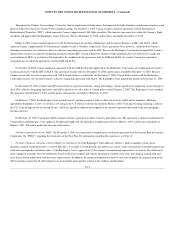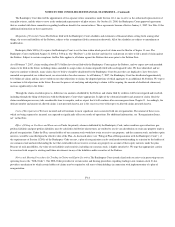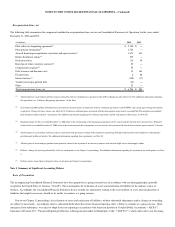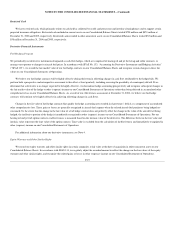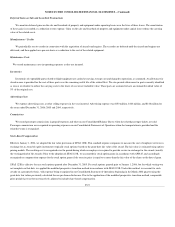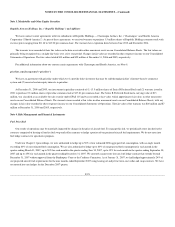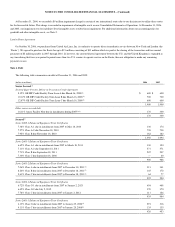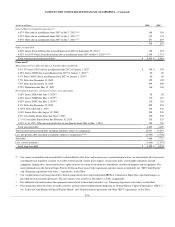Delta Airlines 2006 Annual Report Download - page 81
Download and view the complete annual report
Please find page 81 of the 2006 Delta Airlines annual report below. You can navigate through the pages in the report by either clicking on the pages listed below, or by using the keyword search tool below to find specific information within the annual report.
NOTES TO THE CONSOLIDATED FINANCIAL STATEMENTS – (Continued)
In accordance with SFAS No. 144, “Accounting for the Impairment or Disposal of Long-Lived Assets,” we record impairment losses on long-lived
assets used in operations when events and circumstances indicate the assets may be impaired and the estimated future cash flows generated by those assets are
less than their carrying amounts. For long-lived assets held for sale, we record impairment losses when the carrying amount is greater than the fair value less
the cost to sell. We discontinue depreciation of long-lived assets when these assets are classified as held for sale.
To determine impairments for aircraft used in operations, we group assets at the fleet-type level (the lowest level for which there are identifiable cash
flows) and then estimate future cash flows based on projections of capacity, passenger yield, fuel costs, labor costs and other relevant factors. If impairment
occurs, the impairment loss recognized is the amount by which the aircraft’s carrying amount exceeds its estimated fair value. We estimate aircraft fair values
using published sources, appraisals and bids received from third parties, as available. See Note 5 for additional information about asset impairments.
Goodwill and Intangible Assets
In accordance with SFAS No. 142, “Goodwill and Other Intangible Assets,” we apply a fair value-based impairment test to the net book value of
goodwill and indefinite-lived intangible assets on an annual basis and, if certain events or circumstances indicate that an impairment loss may have been
incurred, on an interim basis. The annual impairment test date for our goodwill and indefinite-lived intangible assets is December 31. Intangible assets with
determinable useful lives are amortized on a straight-line basis over their estimated useful lives. Our operating rights have definite useful lives and are
amortized over their respective lease terms, which range from nine to 19 years.
We had one reporting unit with assigned goodwill at December 31, 2006 and 2005. In evaluating our goodwill for impairment, we first compare the
reporting unit’s fair value to its carrying value. We estimate the fair value of our reporting unit by considering (1) market multiple and recent transaction
values of peer companies and (2) projected discounted future cash flows, if reasonably estimable. In applying the projected discounted future cash flow
methodology, we (1) estimate the reporting unit’s future cash flows based on capacity, passenger yield, fuel costs, labor costs and other relevant factors and
(2) discount those cash flows based on the reporting unit’s weighted average cost of capital. If the reporting unit’s fair value exceeds its carrying value, no
further testing is required. If, however, the reporting unit’s carrying value exceeds its fair value, we then determine the amount of the impairment charge, if
any. We recognize an impairment charge if the carrying value of the reporting unit’s goodwill exceeds its implied fair value.
We perform the impairment test for our indefinite-lived intangible assets by comparing the asset’s fair value to its carrying value. Fair value is estimated
based on projected discounted future cash flows using a similar methodology as described above for goodwill. We recognize an impairment charge if the
asset’s carrying value exceeds its estimated fair value.
See Note 5 for additional information about goodwill and intangible assets impairment charges recorded during 2004.
Interest Expense
While operating as a debtor-in-possession, in accordance with SOP 90-7, we record interest expense only to the extent (1) interest will be paid during our
Chapter 11 proceeding or (2) it is probable interest will be an allowed priority, secured, or unsecured claim. Interest expense recorded on our Consolidated
Statements of Operations totaled $870 million and $1.0 billion for the years ended December 31, 2006 and 2005, respectively. Contractual interest expense
(including interest expense that is associated with obligations classified as liabilities subject to compromise) totaled $1.2 billion for each of the years ended
December 31, 2006 and 2005.
F-21


